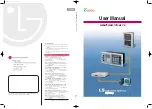
I.L. 17562
Page 91
PR 0.3 Effective 8/99
(Locked Rotor/Thermal Overload). The trip contact blocks motor restarting until the temperature,
as reflected in the thermal accumulator bucket level, cools below the alarm level setpoint I2TA,
P4L2.
NOTE
If stator RTDs are not used and the ambient may rise above 40 degrees C, the ultimate trip
current should be set below that indicated by the nameplate service factor to avoid stator
insulation damage or loss of life.
9.1.2 Overload Protection with RTDs —
Connect from one to six stator RTDs to the optional
URTD module, and connect the URTD data communications output to the MP-3000 using an
optical fiber (recommended) or wired connection. The MP-3000 can then perform enhanced
motor protection in two ways:
1. Direct measurements of the winding temperature are checked against user-programmed
alarm and trip temperature setpoints.
2. The thermal modeling combines the measured temperature with the effective heating current
and the motor constants to more accurately model cooling as a function of temperature
(more heat is dissipated as the temperature rises). Loadability of the motor is much
improved.
If more than one RTD is connected, the hottest of up to six stator RTD temperature
measurements is used for protection. Note that motor bearing, load bearing, and auxiliary RTD
inputs are ignored by the motor thermal algorithm. These other RTD inputs have their own
alarm and trip setpoints.
If stator temperature measurements are available, the algorithm may restrain from tripping even
if the effective current is above the ultimate trip current setpoint, depending on stator
temperature reports. It is still important to set a correct ultimate trip current, so that the motor is
well protected if the RTDs, the module, or its communications to the relay fail - the algorithm
falls back to use of UTC. Also, note that if the winding trip temperature WD T is set to OFF, the
algorithm reverts to the non-RTD calculation which is based strictly on UTC.
NOTE
Many users have the false impression that connecting RTDs makes the motor relay more
conservative and more likely to trip under heavy load conditions. The reverse is actually true -
use of RTDs greatly increases motor loadability. With RTD measurements, the MP-3000 is able
to allow the motor to operate safely with significantly higher sustained levels of loading at normal
ambient temperatures. Along with this, it can effectively protect the motor when the ambient
rises to any level above 40 degrees C. See 9.1.4 below.
9.1.3 Protection Curve —
Refer to the example of Figure 9.2. The motor protection curve
defines the current versus time limit that the MP-3000 develops from programmed setpoint
values. Ideally, this curve is located as close as possible to the motor damage curve for
maximum utilization of the motor capacity. When the integrated effective heating current
squared exceeds this limit curve at any time in the start or run cycle, the MP-3000 trips the
motor.
The MP-3000 automatically calculates the correct motor protection curve from nameplate or
manufacturer values of full-load amperes (FLA, P1L1); locked-rotor current (LRC, P1L2);
maximum allowable stall or locked-rotor time (LRT, P1L3); and service factor as used to set
ultimate trip current (UTC, P1L4). The following subsections describe how such a typical curve
is obtained.
Summary of Contents for 66D2032G01
Page 18: ...Page 18 I L 17562 PR 0 3 Effective 8 99 Figure 4 1 MP 3000 Pushbuttons...
Page 19: ...I L 17562 Page 19 PR 0 3 Effective 8 99 Figure 4 2 MP 3000 LED Indicators...
Page 72: ...Page 72 I L 17562 PR 0 3 Effective 8 99 Figure 6 1 Panel Cutout Dimensions...
Page 73: ...I L 17562 Page 73 PR 0 3 Effective 8 99 Figure 6 2 Faceplate Dimensions...
Page 74: ...Page 74 I L 17562 PR 0 3 Effective 8 99 Figure 6 3 MP 3000 Case Depth Dimensions...
Page 75: ...I L 17562 Page 75 PR 0 3 Effective 8 99 Figure 6 4 Universal RTD Module Mounting Dimensions...
Page 76: ...Page 76 I L 17562 PR 0 3 Effective 8 99 Figure 6 5 Rear Panel Terminals...
Page 78: ...Page 78 I L 17562 PR 0 3 Effective 8 99 Figure 6 7 Typical ac Supply and URTD Wiring...
Page 79: ...I L 17562 Page 79 PR 0 3 Effective 8 99 Figure 6 8 Alternatives for Discrete Input Wiring...
Page 80: ...Page 80 I L 17562 PR 0 3 Effective 8 99 Figure 6 9 RTD Wiring to URTD Module...
Page 100: ...Page 100 I L 17562 PR 0 3 Effective 8 99 Figure 9 1 Rotor Temperature Tracking...
Page 101: ...I L 17562 Page 101 PR 0 3 Effective 8 99 Figure 9 2 Motor Protection Curve...
Page 102: ...Page 102 I L 17562 PR 0 3 Effective 8 99 Figure 9 3 Underload Jam Protection Curve...
Page 104: ...Page 104 I L 17562 PR 0 3 Effective 8 99 Figure 9 5 Motor Protection Curve Example with RTDs...
Page 105: ...I L 17562 Page 105 PR 0 3 Effective 8 99 Figure 9 6 Motor Start and Run Cycles...
Page 109: ...I L 17562 Page 109 PR 0 3 Effective 8 99 P5L8 40 Incomplete Sequence time 1 60s OFF 1 240s...
















































